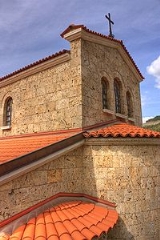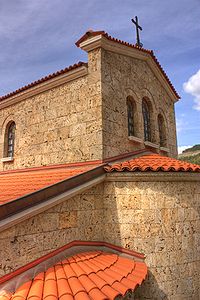
SS. Forty Martyrs Church
Encyclopedia

Veliko Tarnovo
Veliko Tarnovo is a city in north central Bulgaria and the administrative centre of Veliko Tarnovo Province. Often referred to as the "City of the Tsars", Veliko Tarnovo is located on the Yantra River and is famous as the historical capital of the Second Bulgarian Empire, attracting many tourists...
in Bulgaria
Bulgaria
Bulgaria , officially the Republic of Bulgaria , is a parliamentary democracy within a unitary constitutional republic in Southeast Europe. The country borders Romania to the north, Serbia and Macedonia to the west, Greece and Turkey to the south, as well as the Black Sea to the east...
, the former capital of the Second Bulgarian Empire
Second Bulgarian Empire
The Second Bulgarian Empire was a medieval Bulgarian state which existed between 1185 and 1396 . A successor of the First Bulgarian Empire, it reached the peak of its power under Kaloyan and Ivan Asen II before gradually being conquered by the Ottomans in the late 14th-early 15th century...
.
The Holy Forty Martyrs Church is an elongated six-columned basilica
Basilica
The Latin word basilica , was originally used to describe a Roman public building, usually located in the forum of a Roman town. Public basilicas began to appear in Hellenistic cities in the 2nd century BC.The term was also applied to buildings used for religious purposes...
, has three semicircular apse
Apse
In architecture, the apse is a semicircular recess covered with a hemispherical vault or semi-dome...
s and a narrow narthex
Narthex
The narthex of a church is the entrance or lobby area, located at the end of the nave, at the far end from the church's main altar. Traditionally the narthex was a part of the church building, but was not considered part of the church proper...
from the west. Another building was added later to the west side of the church. The church interior was covered with mural painting probably in 1230. On the western addition some of the outer decoration survived revealing the traditional arches and coloured small ceramic plates inserted into the wall. It is not clear if the church has frescoes painted on the outer walls.
Some of the Bulgarian Empire's most significant historical records are stored in the church, including Omurtag
Omurtag of Bulgaria
Omurtag was a Great Khan of Bulgaria from 814 to 831. He is known as "the Builder".In the very beginning of his reign he signed a 30-year peace treaty with the neighboring Eastern Roman Empire which remained in force to the end of his life...
's Column, Asen's Column and the Border Column from Rodosto from the rule of Khan Krum. The columns of Khan Omurtag and khan Krum are written in greek language. The inscription of the column of Krum " Fortress of Rodostro" has been turned upside down. The inscription of Omurtag is about building of a new glorious palace on Danube river ,location is still unknown. The second part of the inscription is a legacy for the new generations to remember the deeds of Omurtag. These columns were placed in the church by Ivan Asen II as a tribute to his mighty ancestors.
History
The church, dedicated to the Forty Martyrs of SebasteForty Martyrs of Sebaste
The Forty Martyrs of Sebaste or the Holy Forty were a group of Roman soldiers in the Legio XII Fulminata whose martyrdom in 320 for the Christian faith is recounted in traditional martyrologies.They were killed near Sebaste, in Lesser Armenia, victims of the persecutions of Licinius,...
, was built and painted on the order of Bulgarian tsar Ivan Asen II in honour of his important victory
Battle of Klokotnitsa
The Battle of Klokotnitsa occurred on 9 March 1230 near the village of Klokotnitsa . As a result, the Second Bulgarian Empire emerged once again as the most powerful state in Eastern Europe and the power of the Despotate of Epirus faded...
near Klokotnitsa
Klokotnitsa
Klokotnica is a village in southern Bulgaria near Haskovo. It has a population of 619 people .The village is famous for the great battle on 9 March 1230, between the Bulgarian tsar Ivan Asen II and the Byzantine Greek despot Theodore Komnin of Epirus...
over the Despotate of Epirus
Despotate of Epirus
The Despotate or Principality of Epirus was one of the Byzantine Greek successor states of the Byzantine Empire that emerged in the aftermath of the Fourth Crusade in 1204. It claimed to be the legitimate successor of the Byzantine Empire, along with the Empire of Nicaea, and the Empire of Trebizond...
under Theodore Ducas on 9 March 1230. The name of the church came naturally as the battle took place on the day of the feast of Holy Forty Martyrs of Sebaste. A royal church during the reign of Ivan Asen II, it was the main church of the Great Lavra monastery at the foot of Tsarevets
Tsarevets
Tsarevets is a medieval stronghold located on a hill with the same name in Veliko Tarnovo in northern Bulgaria. It served as the Second Bulgarian Empire's primary fortress and strongest bulwark from 1185 to 1393, housing the royal and the patriarchal palaces, and is a popular tourist...
on the left bank of the Yantra River
Yantra River
The Yantra is a river in northern Bulgaria, a right tributary of the Danube. It is 285 km long and has a watershed of 7,862 km²....
.
Saint Sava
Saint Sava
Saint Sava was a Serbian Prince and Orthodox monk, the first Archbishop of the autocephalous Serbian Church, the founder of Serbian law and literature, and a diplomat. Sava was born Rastko Nemanjić , the youngest son of Serbian Grand Župan Stefan Nemanja , and ruled the appanage of Hum briefly in...
, the most important saint of the Serbian Orthodox Church
Serbian Orthodox Church
The Serbian Orthodox Church is one of the autocephalous Orthodox Christian churches, ranking sixth in order of seniority after Constantinople, Alexandria, Antioch, Jerusalem, and Russia...
, was first buried at the church after he died on 14 January 1235 or 1236 during a visit to Tarnovo, but his relics were moved to Serbia
Serbia
Serbia , officially the Republic of Serbia , is a landlocked country located at the crossroads of Central and Southeast Europe, covering the southern part of the Carpathian basin and the central part of the Balkans...
shortly after that, on 6 May 1237.
In the first years of Ottoman rule, the church preserved its Christian
Christianity
Christianity is a monotheistic religion based on the life and teachings of Jesus as presented in canonical gospels and other New Testament writings...
character, possibly until the first half of the 18th century. It was then converted to a mosque
Mosque
A mosque is a place of worship for followers of Islam. The word is likely to have entered the English language through French , from Portuguese , from Spanish , and from Berber , ultimately originating in — . The Arabic word masjid literally means a place of prostration...
, with the mural paintings, the icons and the iconostasis being destroyed and alterations being made to the structure itself in 1853. Only a limited number of paintings are preserved, primarily from the northern half of the narthex's west side.
Archaeological research of the church began as early as the 1850s, but excavations were first made in 1906 and 1914, after it was badly damaged by an earthquake
Earthquake
An earthquake is the result of a sudden release of energy in the Earth's crust that creates seismic waves. The seismicity, seismism or seismic activity of an area refers to the frequency, type and size of earthquakes experienced over a period of time...
in 1913. The Forty Martyrs Church was also the location of then-Prime Minister of Bulgaria Stefan Stambolov
Stefan Stambolov
Stefan Nikolov Stambolov was a Bulgarian politician, who served as Prime Minister and regent. He is considered one of the most important and popular "Founders of Modern Bulgaria", and is sometimes referred to as "the Bulgarian Bismarck".- Early years :Stambolov was born in Veliko Tarnovo...
's lavish wedding to Polikseniya Kostaki Stanchova on 18 May 1888. The full independence of Bulgaria from the Ottoman Empire
Ottoman Empire
The Ottoman EmpireIt was usually referred to as the "Ottoman Empire", the "Turkish Empire", the "Ottoman Caliphate" or more commonly "Turkey" by its contemporaries...
was proclaimed by Tsar
Tsar
Tsar is a title used to designate certain European Slavic monarchs or supreme rulers. As a system of government in the Tsardom of Russia and Russian Empire, it is known as Tsarist autocracy, or Tsarism...
Ferdinand on 22 September 1908 in the church.
Systematic archaeological research of the church started in 1969. In 1972, a royal burial of a 1.9 m-tall accoutred man was excavated that included a massive (61.1-gram
Gram
The gram is a metric system unit of mass....
) gold ring bearing a heraldic image and the inscription Kaloyanov prasten (КАЛОIAНОВ ПРЪСТЕНЪ, "Kaloyan
Kaloyan of Bulgaria
Kaloyan the Romanslayer , Ivan II , ruled as emperor of Bulgaria 1197-1207. He is the third and youngest brother of Peter IV and Ivan Asen I who managed to restore the Bulgarian Empire...
's ring") in negative (see photo). After extensive reconstruction works, the Holy Forty Martyrs Church was fully renovated in the 2000s and opened once again to the public, with an official inauguration on 14 September 2006. The church modern looks greatly resembles its medieval structure. Following the church's reconstruction, it has been used as the burial place for the remains of Bulgarian emperors and nobility, among whom Kaloyan of Bulgaria.

